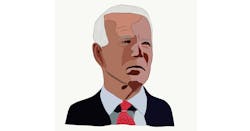Analysis/Commentary
On Oct. 13 President Joe Biden held a publicity event flanked by an army of corporate CEOs, union leaders and government officials where he kicked off an ambitious project aimed at unsnarling the nation’s supply chain mess. However, it appears unlikely to achieve even the plan’s limited declared objectives because it is incapable of addressing the multiple causes that are beyond the administration’s control.
There is nothing wrong with the projects he announced, but they look more like random jabs in the dark than well placed blows. Getting the ports in southern California to operate 24 hours a day won’t hurt anyone, but reports found the ports were virtual ghost towns the first weekend after the President’s announcement. An experiment with 24-hour schedules conducted earlier this year failed to produce any significant increase in efficiency.
Although Biden said we will see significant progress within 90 days, the goal of unloading 3,500 extra containers during the night each week will barely touch the current backlog of 60 or more ships waiting to unload.
Getting other participants in the supply chain to adapt to this schedule is more difficult and costly for any but the largest carriers and shippers. In addition, the solutions proffered so far fail to address many of the issues causing the supply chain breakdown, which is a worldwide problem, stretching from Britain to China.
At base, the supply chain crisis is the result of a collection of system failures that cannot be successfully addressed with a single, seemingly elegant solution. Instead it is a hydra-headed monster where yet another head invariably pops up while you are fighting with the others. Where will they put the unloaded containers? Port facilities are already full to the brim. Chassis are in short supply, and there simply are not enough people working in each of the modal and warehouse links to handle the freight.
The President’s penchant for big splashy press events garnered the media attention he sought, but his other penchant for over-promising has already ignited political blowback, which can be expected to increase as long as the supply chain fails to unsnarl quickly. Experts are projecting it will continue well into next year and perhaps for as long as another full year before we see any major improvement.
At a time when many Americans are already extremely unhappy with Biden’s handling of the Afghanistan withdrawal, border crisis, vaccine mandate and harsh verbal attacks on political opponents, all he seems to have accomplished is to hang the supply chain crisis around his own neck and turn himself into the poster child for the inevitable failure to meet the lofty expectations he created. In fact, it didn’t take very long for some people to dub him “Bare Shelves” Biden.
The current supply chain disruptions have been a long time coming and will be a long time solving. There are no quick gimmicks at hand that will make a substantial difference in the short term. If you glance back at the history of the container and chassis shortages currently plaguing the system, you will get dizzy from the view.
Some problems are intractable. There simply is no more land around most ports for building new cargo handling facilities. In southern California, state and local governments have upped the ante on environmental regulations to the point that it is impossible to build facilities in a reasonable amount of time, and truckers have been banned unless they are driving the most recent model trucks, cutting into the supply of those calling on the ports..
One problem that seems to be here for the long term is the shortage of truck drivers and warehouse workers (which also surfaced as an issue in Europe). Researchers began warning of a shortage of drivers as far back as the 1980s (Ahem! I know because I wrote the first article about it in Transport Topics). Shippers and policymakers largely ignored the issue until they began to feel the pinch during the economic recovery from the Great Recession before the COVID-19 pandemic.
The causes of the driver shortage are multiple, and no one seems to possess the key to solving it quickly or easily—certainly not in time to meet Biden’s 90-day deadline for making progress in reducing port congestion. Good people have been working on the problem for years and will continue to do so.
There are other causes as well. For example, the nation’s freight railroads are hauling less freight than they did 15 years ago due to a change in operational models designed to wring the last penny of costs out of their systems to put into investors’ pockets.
What is evident is that policymakers need to be flexible and plan for the long haul. Logistics professionals have been creative in coming up with possible solutions for everything from computerizing gate operations to applying warehouse automation, but we all need to do more when it comes to developing the labor force we need.
About the Author

David Sparkman
founding editor
David Sparkman is founding editor of ACWI Advance (www.acwi.org), the newsletter of the American Chain of Warehouses Inc. He also heads David Sparkman Consulting, a Washington D.C. area public relations and communications firm. Prior to these he was director of industry relations for the International Warehouse Logistics Association. Sparkman has also been a freelance writer, specializing in logistics and freight transportation. He has served as vice president of communications for the American Moving and Storage Association, director of communications for the National Private Truck Council, and for two decades with American Trucking Associations on its weekly newspaper, Transport Topics.
